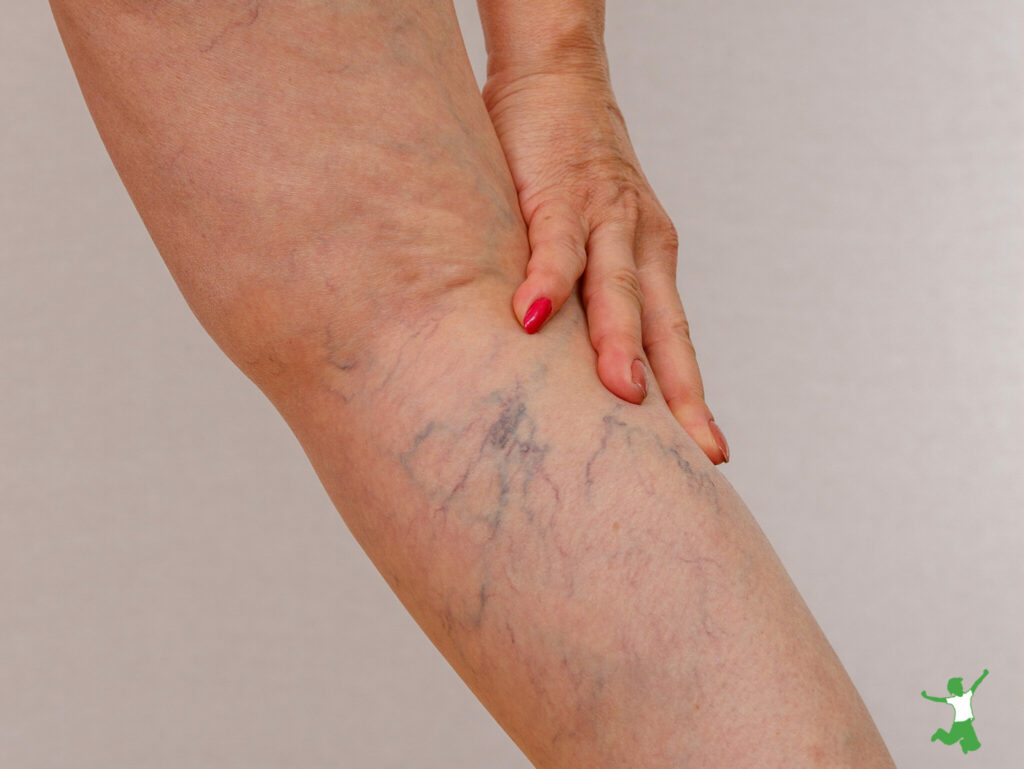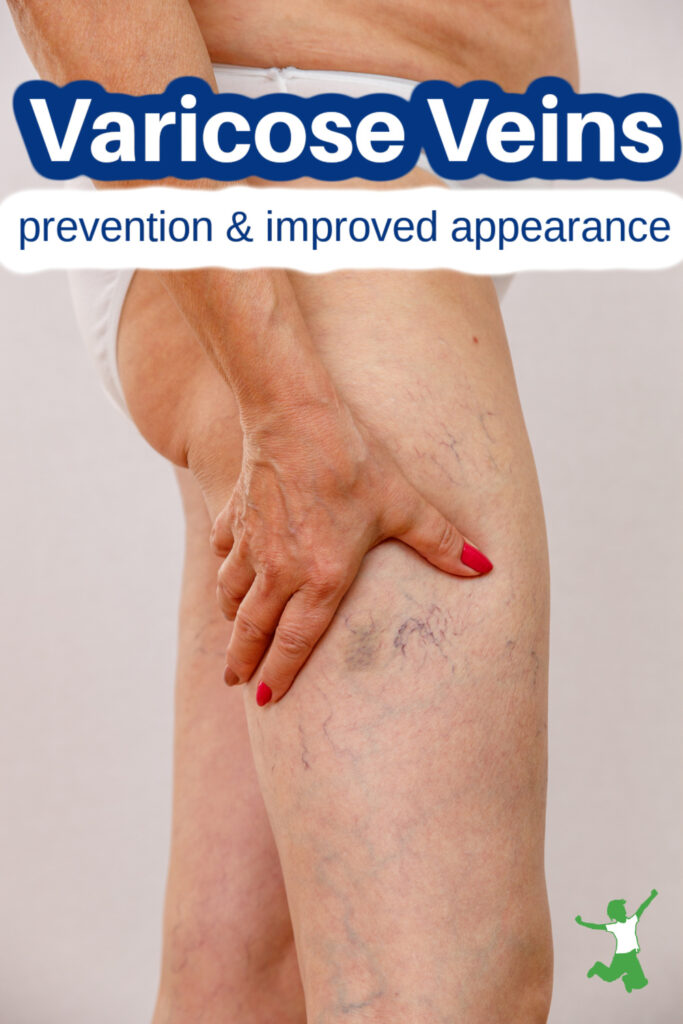Natural methods to prevent and treat varicose veins to reduce their bluish-purple, enlarged appearance and improve the overall circulatory health of the body.

My Grandmother suffered terribly from varicose veins for most of her adult life.
The problems started during her second pregnancy. After a traumatic C-section, she was hospitalized for weeks with phlebitis and subsequent infections from inflammation of the veins in her legs.
The problems never fully resolved, and the on-and-off infections from these very enlarged and engorged veins required a fairly sedentary existence and lower legs perpetually wrapped in cloths soaked in Witch hazel. Ultimately, the situation left her completely chair-bound in her later years.
My mother also has varicose veins, but fortunately, only one that rarely causes discomfort and does not affect her mobility.
The problem arose during pregnancy with her sixth child and was completely preventable in her view. More on that below so you don’t make the same mistake!
What Causes Varicose Veins?
Varicose veins tend to occur as the result of the roughly 50% increase in blood volume and significant weight gain from pregnancy, although men can suffer from them as well.
This could be why there is a correlation between taller women and varicose veins. Greater height increases the distance the veins must transport the blood against gravity to get back to the heart.
While they tend to occur primarily in the lower legs, varicose veins can manifest anywhere venous blood flow becomes sluggish, leading to engorged, swollen veins.
Most people do not realize that hemorrhoids are actually varicose veins too!
There also appears to be a genetic component to varicose veins with 30 genes present in people with the condition.
Thus, those whose mothers, aunts or grandmothers suffered from the condition tend to be at increased risk. (1)
Varicose vs Spider Veins
Varicose veins should not be confused with spider veins although the prevention strategies below would likely help for this related condition as well.
The hallmark symptom of varicose veins is engorged veins that can sometimes have a 3D appearance. The color is bluish to purple.
Spider veins are usually red, smaller and thinner, appearing in a web-like fashion without bulging out of the skin.
Both conditions typically occur in the legs as the result of pregnancy, older age, and obesity. Spider veins may also sometimes appear on the face.
Prevention Strategies
Most women are not aware that there are certain things that can be done to prevent varicose veins even if you are genetically susceptible to their development in your family.
Diet
According to Tom Cowan MD, eating plentiful saturated fats, particularly butter and coconut oil, is important for maintaining proper osmotic pressure in the veins to avoid pooling and enlargement.
Facilitating fat digestion is also critical to ensure the adequate creation of new water in the cells as a primary force for “pushing” the blood uphill in the veins.
To this end, Dr. Cowan stresses that the diet should include lacto-fermented vegetables, particularly sauerkraut, and properly-made bone broths. (2)
Tight-Fitting Clothing
Any clothing that restricts blood flow to and from the legs and feet should strictly be avoided during pregnancy.
In particular, girdles or similar, more modern “suck it all in” undergarments such as Spanx should be off-limits.
Wearing a girdle (in fashion at the time) during pregnancy is how my Mother claims she got a varicose vein (after several prior pregnancies where she did not wear a girdle and had no issues).
I would suggest avoiding pantyhose and leggings too just to be on the safe side. Any clothing that is tight fitting is best left in the closet until after baby is born and blood volume returns to normal.
High Heels
In addition to tight-fitting clothing, high-heeled shoes can contribute to varicose veins.
While wearing them (especially standing for long periods of time), the calf muscles are contracted so that blood isn’t able to completely fill the foot.
After a while, the blood in the leg veins can start to pool, potentially enlarging the veins. (3)
It’s best to stick with flats during pregnancy especially if varicose veins run in the family.
And, if you already have varicose veins, limit the use of high heels or stop wearing them completely.
Herbs
One of my favorite books for prospective mothers is Wise Woman Herbal for the Childbearing Year.
The section on stinging nettle particularly got my attention back in 1998 when I was pregnant with my first child and eager to learn how to prevent varicose veins.
The author suggested stinging nettle infusions as a way to help maintain elasticity in the blood vessels during pregnancy among other benefits. She also warned that tinctures, teas, and capsules of nettle do not produce the same results. (4)
Thus, I drank 1-2 cups of nettle infusion daily throughout all my pregnancies, and credit this habit as one of the primary reasons for avoiding my strong genetic predisposition to varicose veins.
Natural Treatments for Existing Varicose Veins
Prevention is a much more straightforward task than remedying existing varicose veins.
However, the naturally-minded strategies below can lessen the cosmetic issues and discomfort should you already suffer from this condition.
Tannin-Rich Herbs
According to Dr. Cowan, the best-studied herb for varicose veins is horse chestnut.
This herb contains a compound called aesculin, which is a specific nutrient that strengthens the blood vessel walls.
He suggests that:
…the tannins in the horse chestnut “tan” the blood vessels, just like they tan a hide which means they shrink and strengthen the walls. (5)
The Vascular Care Complex from Mediherb (formerly called Horse Chestnut Complex) is his suggested source.
It is a mixture of Horse Chestnut and other tannin-rich herbs. He suggests that the recommended dosage be continued for at least one year for significant symptoms.
Foods Rich in Rutin
The Vitamin C co-factor known as rutin is also helpful for blood vessel support to treat varicose veins naturally.
Foods rich in rutin include buckwheat greens (highest source), apples with the skin, figs, red rooibos tea, elderflower tea, and amaranth leaves. (6)
If you prefer the supplement route, Dr. Cowan recommends the product Cyruta Plus. It contains buckwheat greens, taken at the dose of 2 tablets three times per day. (7)
Exercise
Varicose veins can sometimes contribute to a sedentary lifestyle as was the case with my Grandmother.
Ironically, movement is some of the best therapy for reducing problems and worsening of the condition with age.
Any type of exercise to get the blood moving that correspondingly strengthens the legs and activates the muscles should be engaged in as often as possible (preferably daily) for best results. (8)
Good choices are yoga, walking, rebounding, or any exercise that involves toning the legs.
Intervention for Flare-ups
If despite your best efforts, a flare-up of redness or infection occurs in a varicose vein, Dr. Cowan suggests this natural intervention which should avoid medication in many situations. (9)
- Elevate the legs as much as possible during the day.
- Apply hot compresses with a solution of Epsom salts every 1-2 hours per day
- Take two Echinacea tablets, three times per day.
If there is an intolerance to Echinacea, I suggest concentrated allicin capsules as tremendously effective. It is one of the best natural antibiotics, and what our family has relied on for many years even in lieu of meds after outpatient surgery.
What to NEVER Do with Varicose Veins
While exercise is excellent for improving blood flow in the legs to reduce the appearance of varicose veins and prevent them from getting worse, it is important to never use fascia-blasters to artificially stimulate the area.
While these popular devices are marketed as an easy way to improve circulation, in areas where varicose or spider veins appear, their use can sometimes worsen the severity of the situation.

(1) Are Varicose Veins Genetic?
(2) Here’s Why Your High Heels May Be Causing Varicose Veins
(3, 5, 7-9) Ask the Doctor: Varicose Veins
(4) Energize and Enjoy with Nettle
(6) Foods that Contain Rutin








Hi Sarah,
I was glad you added this article on varicose veins. I have them behind my knee (am not pregnant) so I was looking for some natural remedies. I noticed in one of your previous articles on the many uses of witch hazel, that you recommended using witch hazel compresses to help with varicose veins. I didn’t see it mentioned here but wanted to check with you to see if it is still something you think may help.
Thank you for all your very helpful articles!
Nancy
Yes, witch hazel is very good for shrinking/soothing hemorrhoids which are varicose veins of the rectal area. The cloths my Grandmother wrapped her legs with were soaked in Witch hazel. They provided more temporary relief than healing though from what I observed. Thank you for mentioning that.